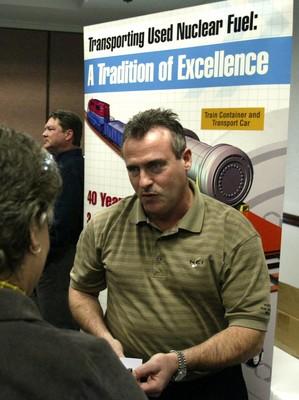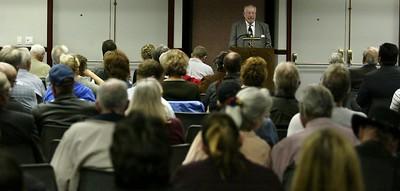Yucca plans draw public’s ire
Southern Nevadans showed up in force Monday to voice concerns about the planned Yucca Mountain nuclear waste repository, saying the transportation risks are too great, the design has too many shortcomings and the government's nuclear weapons testing track record cast doubt on the project.
One speaker, Ian Zabarte of the Western Shoshone National Council, drew some of the loudest applause from the crowd of more than 200 that packed a hearing room at the Cashman Center when he accused the Energy Department of "environmental racism."
"A moral people with ethical scientists cannot condone the use of such practices to the benefit of the nuclear industry," Zabarte said. He suggested that tribes along all transportation corridors "and especially those with tourism-based economies and gaming facilities must be assessed for stigma-related impacts."
"Transportation of waste to Yucca Mountain would place a disproportionate burden upon the Western Shoshone nation and has not been addressed in the (supplemental impact statement). It is environmental racism," he said.
Only a handful of the 53 who signed up to speak at the hearing favored the Energy Department's plans. They said the draft supplemental impact statement for surface facilities to handle nuclear waste canisters, and another analysis of building a rail line from Caliente to reach the mountain, are improvements over the final impact document issued in 2002.
"The fact the SEIS (supplement) shows impacts to Nevada from transportation is small confirms what we found," said Paul Seidler, a senior director for the Nuclear Energy Institute in Las Vegas. The institute is a lobbying organization for the nuclear power industry.
In all, 212 people, most from Southern Nevada, attended the hearing in addition to the two dozen Energy Department employees and consultants on hand to answer questions and explain exhibits.
In comparison, Yucca Mountain hearings last month in Hawthorne, Caliente, Reno-Sparks, Amargosa Valley, Goldfield and Lone Pine, Calif., drew a combined 244 public attendees. Of those, a total of 71 spoke at the hearings, said Allen Benson, the senior Department of Energy official and spokesman at the Las Vegas hearing.
"It's a tremendous turnout," he said. "I think a lot of people take this seriously. It's important that they come out and talk to us about their views."
That they did, from the first speaker, Las Vegas Mayor Oscar Goodman, to a former Yucca Mountain Project worker, Robin Drew, who bemoaned how project officials have opposed her in a legal battle over compensation for carpal tunnel syndrome.
Goodman weighed in on the federal agency's plans for transporting nuclear waste across the nation and especially through the Las Vegas Valley, saying privately before he took the podium, "It's a disaster waiting to happen."
In his public comments, Goodman said, "If the material is as safe as we're told it is, let it stay where it presently exists."
He said no one can guarantee that an accident won't happen "or, God forbid, the act of a terrorist."
Robert Halstead, transportation adviser for the Nevada Nuclear Projects Agency, emphasized in his remarks that spent fuel "is lethal" and that the 77,000 tons of it and highly radioactive defense waste destined for a maze of tunnels to be dug in Yucca Mountain contain far more fission products than were released by the nuclear bomb dropped on Hiroshima, Japan, in World War II.
Each truck cask of spent nuclear fuel would contain 350,000 curies of radioactive cesium and strontium, or about 20 to 30 times the amount of fission products released by the Hiroshima bomb, Halstead said.
"Every dedicated train hauling three or four rail casks would contain more cesium-137 than the total amount released during the Chernobyl nuclear power accident," he said.
Halstead noted that since the DOE's last impact statement five years ago, the residential population within a half-mile of the rail route through Las Vegas has doubled, from 45,000 to about 90,000.
Irene Navis, planning manager for the Clark County Nuclear Waste Program, said the Energy Department's plans lack details, especially regarding an increased inventory of waste to be disposed that one project official has said will increase the life-cycle cost from $58 billion to $78 billion.
"We don't know what's up with a second repository," Navis said.
In concept, she said, there could be "twice as much waste, which means twice as many shipments for twice as many years. ... So far it's not clear. We're looking for answers."
Contact reporter Keith Rogers at krogers@reviewjournal.com or (702) 383-0308.
More aboutYucca Mountain
FURTHER ARGUMENTS WEDNESDAY
A Nuclear Regulatory Commission board will hear oral arguments Wednesday regarding Nevada's challenge to the Department of Energy's certification in October of its document collection to support a license application for the planned Yucca Mountain nuclear waste repository.
The board will begin the proceeding at 9 a.m. in the commission's Las Vegas Hearing Facility, Pacific Enterprise Plaza, Building 1, 3250 Pepper Lane. Attendees should allow enough time for security screening.
Also Wednesday, the last in a series of public hearings on impact statements for the proposed repository and a rail line to haul spent fuel and highly radioactive defense waste to it will be held in the nation's capital. The hearing is scheduled for 2 p.m. to 5 p.m. Eastern time at the Marriott at Metro Center, 775 12th St., in northwest Washington, D.C.



















